



























Heard enough from old white men. Seeing these words on the t-shirt of a fellow public transport user recently left me strangely uncomfortable. I’ve waxed forth frequently about not generalising about people in this manner, not stereotyping fellow human beings based on race and gender, religion and language, age and sexual orientation.
And yet this week, the lack of respect towards women we have seen from a certain section of the Australian community has left us gobsmacked.
Demeaning comments targeted at women have been made by men in positions of social power - politician David Leyonhjelm in Parliament, and Australian entertainment personality Bert Newton at the Logies. Sporting legend Barry Hall was a similar culprit on Triple M radio, but has since apologised for his unacceptable behaviour.
Worse still, the offenders - a media icon, a politician and a sporting legend - failed to understand the gravity of their comments.
While Hall has been stood down from his role on radio, Newton and Leyonhjelm refuse to accept their mistakes and see no reason to apologise.
Eighty-year-old TV star Newton, an MBE, and recently honoured by Australia Post with a series of postage stamps, told an offensive joke about his late, great friend Graham Kennedy at the 2018 Logie Awards ceremony. “He was a great mentor,” he said, adding, “You knew if you went to his dressing room and it was locked, he will be inside doing some mentoring”.

Days later, Newton fails to understand that his ‘joke’ condones the behaviour of powerful people who use their clout to exert influence on younger people in return for sexual favours.
Leyonhjelm, a Liberal Democratic Party senator, used derogatory language while speaking with Greens Senator Sarah Hanson-Young and again when referring to her afterwards. Despite intense political pressure from both Prime Minister Malcolm Turnbull and Opposition leader Bill Shorten, and threats of legal action, Leyonhjelm is refusing to apologise, saying he has said nothing wrong. As we go to press, his direct verbal attacks on women continue on mainstream TV.
Amazing that this type of behaviour
continues when the #MeToo movement is so strong. Leyonhjelm in his own way is hitting back at #MeToo, citing previous statements made by the Greens Senator against men.
The trumpet call for greater diversity in our social discourse needs to be heard now more than ever. Because the Newtons and the Leyonhjelms will continue as long as we continue to have concentrations of social power that are not diverse.
The massive over-representation in positions of power by certain sections has gone on for way too long. Whether in business or in politics, entertainment or sport, we need to hear the diverse voice louder and clearer. We must ensure that more women, more people of colour, more people of different religions are able to educate themselves, accumulate wealth and attain positions where they can take decisions. As leaders who reflect a diverse population, they will influence and inspire one another, thrive together, and shape our society to be truly equitable.
And to the men in positions of power making these denigrating comments –perhaps it’s time to use the family test. What would you do if someone hurled profanities at your wife, sister or daughter? Would you take it sitting down?

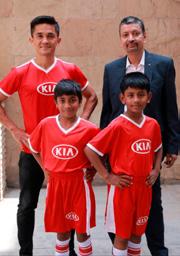


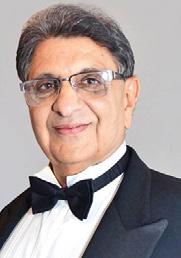




































Our piece on Nandita Das from the sidelines of the Sydney Film Festival last month, written by RAJNI ANAND LUTHRA and CHARUTA JOSHI, was featured on India’s largest independent news service Indo-Asian News Services (IANS). It was picked from there by a number of media outlets in India and in the diaspora, including Business Standard, Times of India, Bollywood Life, India TV, Cinestaan, Times Now, 5 Dariya News, India Life, Daiji World, The Rahnuma, Ashoka News, New Kerala, The News Room, Live Uttar Pradesh, News Dog App and India New England.

In our June-2 2018 edition we featured the eight Indian-origin honourees in the Queen’s Birthday Honours list this year

Kanti Jinna OAM wrote: Thank you sincerely for your kind words attributed to me in my interview with you. Your interview has gone around my friends and relatives in several countries around the world including Fiji of course and has had excellent mileage for me in particular and Indian Link in general. Thanks also for sending me a copy of your lovely news magazine featuring all the other Queen’s Birthday honours recipients. I will treasure it. Grateful for efforts to share this happy moment in our lives with your readers. Dr Sudarshan Sachdev OAM wrote: Thanks for your excellent and factual article about me and my family. I really appreciate your professional presentation
De Silva Hebron Barristers & Solicitors wrote: Fantastic article!









Arvind Shrivastava OAM wrote Thanks for the compliments; the article reads very well. Really appreciate your kind efforts.

Our June-1 2018 edition cover feature ‘Money Matters’ looked at how people across different age groups are navigating their nancial lives. Dilip Jadeja wrote: I browsed through three cases that I thought were of likely interest to me, all of couples. By far, all was as I expected. Nothing new. My guess was as good on what most things would be. But I did like that most people had their wills sorted out. I have always advocated that wills be executable and permanent when folks are alive, not challengeable when they are dead. Governments are yet to learn that.
This kitchen has never smelled so spicy or smoky George Calombaris on MasterChef AU guest judge Saransh Goila’s butter chicken pressure test

#WanderlustWednesday | We asked our readers to guess where in India they would nd this magni cent reservoir. Raj Saneja correctly identi ed it as Bhakra dam. Well done!

HAMIDA PARKAR analysed two lms, Manto and Mehsampur, at the recent Sydney Film Festival. Nandita Das tweeted: Insightful piece on #Manto and #Mehsampur, two lms at the Sydney Film Festival. Look forward to seeing Kabir Chowdhry’s lm (he was an 8-year-old in Fire!) Time ies.


Australia’s ‘bag rage’ against the single-use plastic ban: Do you think people are over-reacting?

Yes: 51%
No: 49%
We’re delighted to have been awarded $5million by the Commonwealth Dept of Education to strengthen Australia-India education links Australia India Institute





Ambani, Mittal, Birla, Kotak – if there’s one thing that’s common across all these names, what would you say it was? Power. These names – and the people behind these names – are the ones that have for years now influenced the direction that India has progressed in, economically and otherwise. They are the brands that
dominate India’s stock market, and for good reason.
Through extensive research, checks and cross-checks, London-based media house RAYMEDIA came out with its third edition of the list in 2017 that combines 160 Indians, non-resident Indians and persons of Indian origin or overseas citizens of India.

The qualification for inclusion on the list
is a minimum net worth of US$1 billion or its equivalent. The aggregate net worth of the people featuring on the list is well over 20% of India’s GDP. As one might expect, the names are pretty much the same with a slight shu e here and there. Indian Link, which has the exclusive Australian rights to publish the list, brings you the top 25 names from the list here (see full list on our website indianlink.com.au).
The template for the compilation was created by Philip Beresford, one of the most experienced wealth estimators in the world. He has been compiling the UK’s Sunday Times annual rich list for 27 years.
The net worth figures are best estimates and subject to fluctuation, given the volatility of the markets. All figures are in US dollars.
Here are the wealthiest Indians of 2017.

Mukesh Ambani remains the richest person in the Indian diaspora. His Reliance Industries Limited is a petrochemicals, oil and gas giant which provides around 5% of the Indian government’s tax revenue. In the telecom sector he has launched 4G services called Jio, which in one year has secured 130 million subscribers by offering free or virtually free services. Reliance also directly or indirectly controls several television channels, including news networks. According to an MBA student at Stanford Business School in California, his home in Mumbai is the world’s most expensive residential property. He owns about a third of his company. His interests include ownership of Mumbai Indians in the Indian Premier League and promoting the Indian Super League football.

Software
$19.4 billion
After his father’s death in 1966, Azim Premji had to cut short his studies in electrical engineering at Stanford University to take charge of the family business. He turned it from a seller of hydrogenated cooking fats, soaps and other consumer products into Wipro (short for Western Indian Vegetable Products), the third largest Indian software exporter, which has since 2000 been quoted on the New York Stock Exchange. His acquisitions include Florida based insurance technology rm HealthPlan Services. He has pledged 39% of his stake in Wipro to his charitable trust.

Various
$18.6 billion
The Hinduja Group have assets in truck-making, lubricants, banking, energy, chemicals and cable TV. The Old War Of ce in London that they bought for £350 million, is being re-launched as a hotel. They also started NXT Digital, a digital TV distributor, in India. Captained by the second of four brothers, Gopichand, their businesses include India’s second biggest truck maker Ashok Leyland, British electric bus maker Optare, interests in Gulf Oil, US chemical company Houghton and IndusInd Bank, which has a presence in Switzerland, India and Britain.


Born in Mumbai, the Jewish family started out in metals. Their property portfolio includes prime buildings in London, airports and heliports. They are leading investors in the UK’s Metro Bank and still own 51% of Global Switch, a data hosting company, having sold 49% to Chinese investors Elegant Jubilee for $3 billion less than a year ago. Grosvenor House Hotel in London and Plaza Hotel in New York are mortgaged to them against loans granted to Sahara India. Reubros and Aldersgate Investments, controlled by them, are estimated to be worth $14 billion.
$17 billion
The Mistry family have a stake of 18.5% (the largest) in the $126 billion Tata Group. His son Cyrus is locked in a legal battle with the Tatas, after being ousted as chairman of Tata Sons in 2016. Mistry heads Shapoorji Pallonji Group, pioneering builders in India since the 1860s, credited with the creation of some of India’s most iconic structures. Since the 1970s, the company has also had a signi cant presence in the Gulf. It is presently engaged in a $200 million venture to construct 20,000 affordable homes in India. Mistry, recipient of the Padma Bhushan - is now an Irish citizen.
India
Software
$13.3 billion
HCL Group, co-founded by Shiv Nadar in 1976, began by selling microcomputers, and is now India’s 4th largest software rm. Its customers include Boeing, Microsoft, Cisco and UBS. HCL also invested $780 million in an intellectual property partnership with IBM. Nadar also possesses a $100 million art collection.
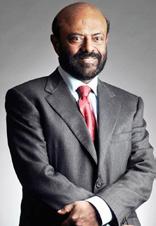
As chief executive of the Luxembourg-headquartered ArcelorMittal, Lakshmi Mittal seems to be as strong as the steel he makes. After a $7.9 billion loss in 2015 due to an industry-wide crisis caused by over-capacity and dumping by China, the world’s largest steelmaker made a pro t of $1.8 billion in 2016. Mittal moved from Kolkata to Indonesia before settling in Britain in 1995, where he was declared the wealthiest person for eight years, but is now only 11th on the Sunday Times Rich List.


India
Aluminium, Cement & Telecom
$12.6 billion
Hindalco Industries, a part of Birla Group, is India’s second largest aluminium maker. It acquired Atlanta-based Novelis for $6 billion in 2007 and bought the rival Jaypee Group for $2.4 billion. Birla also launched a fashion portal abor.com. He merged his rm Idea Cellular with Vodafone India to compete with Reliance Jio.


In 1918, the Godrej Group, now headed by MIT graduate Adi Godrej, with brother Nadir and cousins Jamshyd and Smita Crishna-Godrej part of the empire, launched the world’s rst soap product made from vegetable oil. After 120 years, it is now involved in real estate, industrial engineering, appliances, furniture, security, agriculture, and consumer goods – ranging from mosquito repellents to refrigerators – that are also sold in other parts of Asia, Africa and South America. Godrej Properties is now developing its vast and nearly 100-year land holdings – its biggest asset - in suburban Mumbai.

Pharmaceuticals $11.6 billion
Despite drop in shares, Shanghvi’s company remains India’s biggest rm in the sector and the 5th largest generics maker in the world after acquiring rival Ranbaxy Industries for $4 billion in 2014. In 2016 it introduced a generic version of Gleevec, a cancer drug made by Novartis, in the US.
Infrastructure & Energy
$11 billion
Adani is known as much for his business interests in ports and power as he is for his association with Narendra Modi. In 2014, he acquired major ports in eastern and southern India. He has received approval for a coal-mining project in Queensland but the plan has also raised environmental concerns.

Investor
$9.6 billion
A jump from No 134 to 14, Damani’s net worth is a result of an IPO of his hypermarket chain D-Mart. He has a 26% share in cigarette maker VST Industries and in India Cements. Damani has also acquired the Radisson Blu Resort in Alibag, a beach getaway near Mumbai.


Financial Services
$10.2 billion
Uday set up Kotak Capital Management Finance in 1985 and converted it into Kotak Mahindra Bank in 2003. After acquiring ING Vysya Bank, it is now India’s 4th largest bank. It also has a stake in MCX, India’s largest commodities exchange. Kotak Mahindra Bank also owns Business Standard, an Indian financial daily.

Pharmaceuticals
$8.9 billion
From owning stud farms in Pune, Cyrus Poonawalla and his brother Zavaray launched Serum Institute of India in 1966. It is now the world’s largest producer of vaccines; every second child in the world is inoculated by a vaccine from SII. Its range of new vaccines includes one for dengue.

Telecom
$10.2 billion
Bharti Airtel, controlled by Mittal with SingTel of Singapore, is the world’s third largest telecom company by way of subscribers. Airtel is engaged in a price war with Reliance Jio in the 4G data space. It enjoys a presence in 18 countries in Asia and Africa. Mittal has also launched Airtel Payment Bank.
$7.6 billion
Savitri Jindal took charge after the death of husband Om Prakash in 2005, and delegated the four divisions of the company – steel, power, mining and oil and gas – to her sons, Prithviraj, Sajjan, Ratan and Naveen. Apart from JSW Steel operated by Sajjan, the other businesses have declined.

Migration Law
n Skilled Migration Visas
n 457 Visas/Visitor Visas
n Business Investment Visas
n Partner Visas and Family Visas
n AAT Merits Review and Federal Appeals
Family Law
n Divorce

n Property Settlement
n Parenting Orders/Plans
n Domestic Violence ADVO
n Consent Orders, Financial Agreements
Business Law
n Shareholders and Share Sale Agreement
n Drafting of Contracts, Leases, Debt Recovery


n Sale and Purchase of business, including franchises
Property Law/Conveyancing

n Sale/Purchase of Residential and Commercial Property

$6.8 billion
Eicher, which used to make tractors, switched to manufacturing motorbikes by acquiring a stake in Enfield India. After growing more than 50% annually since 2010, it has partnered with Volvo to make trucks and personal utility vehicles. Vikram Lal, who oversees operations with his son Siddhartha, commands a 55% share.
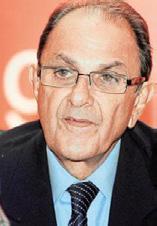
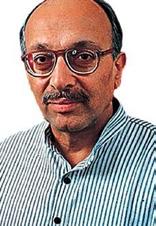
Cement
$6.3 billion
Inheriting an underperforming cement company in a family carve out in 1992, Bangur turned it around. Kolkata-based Shree Cement has in recent years maintained its buoyancy despite bearish demand. Bangur is reputed to reside in a 51,000 square foot mansion which possesses a temple, home theatre, a gym and volleyball court.

$6.6 billion
A new entrant, Acharya Balkrishna’s rise has been meteoric. Patanjali Ayurved is a joint venture with Baba Ramdev, a yoga teacher who is close to the current ruling party in India. Balkrishna holds 98.6% of the company, which sells a range of products, including toothpastes, cosmetics, noodles and jams.

Various
$6 billion
The Wadia Group, a marine construction company for Britishers, today owns Bombay Dyeing and Manufacturing Company, Bombay Burmah Trading Corp, Britannia Industries and many properties in Mumbai. It also promoted Go Air, an Indian airline. Ness, Nusli Wadia’s son, has a stake in IPL Twenty20 cricket franchise King’s XI Punjab.
$6.4 billion
Indorama is the world’s largest producer of polyester. In addition to Indonesia, it has production plants in Malaysia, India, Sri Lanka, Uzbekistan, Turkey and Senegal. In London, he and his wife Seema bought and restored a 1772 five storey mansion known as Sheridan House for around $66 million.


$5.9 billion
He heads DLF, India’s largest urban development company with son Rajiv. Shares have tumbled by a third in 2015-16 due to low demand and debt rose to $3 billion. But Singh sold his 40% stake in DLF’s rental arm to Singapore sovereign wealth fund GIC for $1.9 billion to stabilise the situation.

send Money Overseas most reliably and securely within 10 minutes through moneygram send Money to any bank account at the best rate and flat fee of $15 (No Limits applicable on amounts) exchange your currency with us, we give the best rates and do not charge any commission send money to our own branches in all major towns and cities in Fiji and New Zealand



Ask us about our commercial business, we do import payments and all international business related remittance at best rate and a flat fee of $15.00 only


Auto Parts
$5.9 billion
Co-founded in 1975 by Sehgal and his mother, it is now a leading manufacturer of car components, with a tie-up with Japan’s Sumitomo, which owns 25% of the company. Its clients include Volkswagen, Porsche, Mercedes-Benz, BMW, Ford and Toyota, with 230 factories in 37 countries including Europe and South America.
Rahul Bajaj and family
$4.7 billion (Motorcycles) India
Ajay Piramal
$4.7 billion (Various) India
M A Yusuff Ali
$4.6 billion (Retail)
UAE
Subhash Chandra
$4.5 billion (Media) India
Kalanithi Maran
$4.5 billion (Media)
India
Kapil and Rahul Bhatia
$4.3 billion (Aviation and Hotels)
India
Harsh Mariwala and family
$4.2 billion (Consumer Goods) India
Pawan Munjal and family
$4.2 billion (Motorcycles) India
Mangal Lodha and family
$4.1 billion (Property Development)
India
Micky Jagtiani $4 billion (Retail & Hotels)
UAE
Ravi Pillai
$3.8 billion (Construction)
UAE
Bavaguthu Shetty $3.8 billion (Healthcare & Foreign Exchange)
UAE
Vinita and Nilesh Gupta
$3.6 billion( Pharmaceuticals)
India
Kuldip Singh and Gurbachan Singh
Dhingra
$3.5 billion (Paint)
India
Sudhir and Samir Mehta
$3.5 billion (Pharmaceuticals & Power)
India
Pharmaceuticals
$5.6 billion
Pankaj Patel’s Cadila Healthcare claims to have discovered a new drug for diabetes. Its Zydus Wellness division makes a popular sugar substitute called Sugar Free. It took a hit when US authorities warned it of contravening manufacturing standards. Around 30% of its annual revenues come from the US.
Radhe Shyam Agarwal & Radhe Shyam Goenka
$3.5 billion (Health & Personal Care Products) India
Karsanbhai Patel $3.5 billion (Various) India
Shashi and Ravi Ruia
$3.4 billion (Energy & Logistics) India
Ashwin Dani $3.3 billion (Paints) India
Baba Kalyani $3.3 billion (Various) India
Samprada Singh and family $3.3 billion (Pharmaceuticals) India
Anil Agarwal $3.2 billion (Metals & Oil) UK/India
Romesh Wadhwani $3.1 billion (Private Equity) USA

Indu Jain and family $3 billion (Media) India
Ashwin & Mahendra Choksi and family $3 billion (Paints) India
Rakesh Gangwal $3 billion (Aviation) USA
Rai Gupta family $3 billion (Electricals) India
Rakesh Jhunjhunwala $3 billion (Investor) India
Hasmukh Chudgar $2.9 billion (Pharmaceuticals) India
P V Ramprasad Reddy $2.8 billion (Pharmaceuticals) India
Raj Kumar & Kishin R K $2.8 billion (Property Development) Singapore
Rajan Raheja and family $2.8 billion (Various) India
Chandru Raheja $2.8 billion (Property Development) India
Sameer Gehlaut (Property Development) $2.8 billion India
Kishore Biyani and family $2.8 billion (Retail) India
Feroz Allana $2.7 billion (Food) UAE
Rishad Naoroji $2.7 billion (Inheritance) India
Abhay Vakil and family $2.7 billion (Paints) India
M G George Muthoot and family $2.7 billion (Financial Services) India
Rajesh Mehta and family $2.6 billion (Jewellery) India
Vijay Chauhan and family $2.5 billion (Biscuits) India
Abhay Firodia $2.5 billion (Vehicles) India
A Krishnamoorthy and family $2.5 billion (Tractors) India
Dalmia family $2.5 billion (Cement) India
Murugappa family $2.4 billion (Various) India
Adhesives
$4.8 billion
Pidilite Industries, owned by the Parekhs, owns Fevicol, M-Seal and Dr. Fixit, household names in India. Its share values continue to rise. Madhukar, who has an MSc degree from Wisconsin University, inherited Pidilite from his father who died in 2013. The family have a 70% stake in the business.
Vinod Khosla $2.4 billion (Private Equity) USA
Aloke Lohia $2.4 billion (Textiles) Thailand
Mansoor and Aminmohammed Lalji & family $2.35 billion (Property Development) Canada
Sunil Vaswani $2.3 billion (Transport and Food) UK/Nigeria/UAE
Kiran Mazumdar-Shaw and John Shaw $2.3 billion (Bio-Pharma) India
Sunny Varkey $2.3 billion (Education) UAE
Rajendra Agarwal and family $2.3 billion (Pharmaceuticals) India
Anil Ambani $2.2 billion (Various) India
Murali Divi (Pharmaceuticals) $2.2 billion India
Harsh Goenka $2.2 billion (Various) India

Leena Tewari (Pharmaceuticals) $2.2 billion India
Sanjiv Goenka $2.1 billion (Various) India
Kavitark Ram Shriram $2.1 billion (Private Equity) USA
Mofatraj Munot $2.1 billion (Property Development) India
Jitendra Virwani $2.1 billion (Property Development) India
Vikas Oberoi $2.1 billion (Property Development) India
Vivek Chand Burman $2 billion (FMCG & Natural Healthcare) India

B Parthasaradhi Reddy $2 billion (Pharmaceuticals) India
Arvind Tiku $2 billion (Oil & Gas) Singapore
Lachhman Das Mittal $1.95 billion (Various) India
Murli and Bimal Gyanchandani $1.95 billion (Detergents) India
N R Narayana Murthy $1.9 billion (Software) India
Juneja family $1.9 billion (Pharmaceuticals) India
Simon, Bobby and Robin Arora $1.9 billion (Retail) UK
Ranjan Pai $1.9 billion (Education & Healthcare) India
Anurang Jain $1.9 billion (Auto Parts)
India
Anand Burman $1.8 billion (FMCG & Natural Health Care)
India
Genomal family $1.8 billion (Garments) India
Singhal family $1.8 billion (Agrochemicals) India
Nandan Nilekani $1.75 billion (Software) India








Book now by calling 9415 1977 or visit any of our campuses or download the enrolment form at www.north-shore.com.au



Exam Content:
Exam Date: Location: Cost: Closing Date: Results:

One Written assessment and 3 multiple choice tests consisting of English, Mathematics & General Ability

Sunday, 19 August 2018 (1:30 - 5:30pm)
Southee Complex (Hall 5A), Sydney Olympic Park $50 (Non-refundable fee)
Sunday, 12 August 2018

As the only contestant to ever have scored the hallowed immunity pin twice on MasterChef Australia, Sashi Cheliah is definitely sleeping better these days.

Sashi laughs and responds, “You bet I do. Few people on this show have had the privilege of doing something unique. I’m so happy and equally proud of myself.”
He’s a man of few words. But his unassuming nature doesn’t get in the way of his excitement at having come a long way since Day 1. “I never thought I’d get this far. Before this show, I wondered ‘how can my dishes or my style of cooking possibly get me into a show of this calibre?
I’m just a home cook’ but now I know: if you hit the flavour profile, you’re here to stay. It doesn’t have to be a complex dish, but when the judges take a spoonful, they have to say ‘Wow!’”
For Adelaide-based and Singapore-born Sashi, though, MasterChef Australia was a happy accident, in his own words.

“When I came to Adelaide, I really
missed food from back home. So whenever my wife and kids felt like having authentic Singaporean or Indian food, I’d end up cooking it myself. I’d talk to mum or my aunts and get recipes from them or check out YouTube videos,” Sashi tells Indian Link.
Word spread and friends and family urged him to try out for the cooking competition.
“They started telling me that I should open up my own restaurant,” he says, laughing. “And for some reason, last year I kept seeing MasterChef ads popping up on my FB feed. I think that was a sign – plus I was looking to start my own business. So I figured ‘Why not food business?’ I thought if there was some way I could get into the contest, it would be a great stepping stone for me. But honestly, I couldn’t believe I got the apron on the first day of auditions! It was a huge confidence boost.”
Sashi moved to Adelaide in 2012. The eldest of seven children, he is a third-generation Singaporean whose grandparents came from Madurai and settled there.
Sashi grew up to be in the Star Unit of the Singapore Police Force for nearly a decade, and was trained in special tactics and rescue operations. He worked in
counter terrorism, kidnappings and highprofile protection in the riot police. Now living in Adelaide, he works at a women’s prison.
Sashi’s earliest memories of food are that of his mum working in their café. “We were introduced to cooking at a really young age because of mum who used to run a café. But it never really interested us then. We saw the toll it took on mum, the working hours were just merciless.”
At the time, Sashi believed that “cooking
just wasn’t his cup of soup”. And so, he says, he decided to get into the police force.
“But food was never far away,” Sashi recounts. “We were a joint family – my many aunties, uncles and cousins living together. So a lot of my cooking is influenced by them, especially Indian cuisine.”
Thanks to Sashi and other Indian contestants on the show – Loki Madireddi, Nidhi Mahajan, Rishi Desai, etc. – Indian dishes are hitting the spotlight in a big

Two immunity pins and Top 10 of Masterchef Australia: Sashi Cheliah is busy making history of sorts
way. “I think Indian cuisine is undergoing a huge makeover, especially over the last couple of years. People are really beginning to experiment freely with Indian fusion – where the flavours are predominantly Indian but are done up with a western touch,” Sashi agrees.
His Lychee Duck, which he cooked during a team challenge recently, is one such example. “I’m really proud of that dish. It was a fusion of Indian and Thai flavours. Typically you wouldn’t use lychee in an Indian curry preparation, although it’s a fairly common fruit in Thai cuisine. But I decided to take the risk and it paid off big time. The judges really loved it!”
He adds, “Fans of the show in India love it when Indian contestants like us come on the show and try to recreate Indian dishes with different techniques and new ingredients. It’s so encouraging – and that’s what cooking is all about, trying something new every day,” Sashi says.


Although he loves south-east Asian food,
Indian food occupies a special place in Sashi’s heart. “I grew up eating food from a lot of different cultures. But my absolute favourite has got to be biryani, I can have it any time of the day. I also love south Indian vegetarian thali, dosa, idli. I prepare my own batter. I love upma too. And oh, Indian desserts – halwa, kesari! There’s nothing else in the world like Indian sweets. It’s such a diverse cuisine and there’s so much depth of flavour. You can spend years eating and you still wouldn’t be able to taste every single Indian dish.”
He has used one of his pins in a recent pressure test, but Sashi is still cooking up a storm in the kitchen. He has now made it to Top 10, and is the ‘curry sauce man’ thanks to the different varieties of sauces he has come up during the competition, his food all the while reflecting his roots. Here’s hoping this foodie enthusiasm carries Sashi even further in the competition – with him in the top 10 and the trophy so close, we’ve got our fingers crossed.
Sweet or savoury
Savoury
Immunity pin or a chance to cook for Nigella
Immunity pin
Tea or coffee Coffee
Favourite comfort food
Sambar and rice
A recipe you are a master of Chicken curry
One dish you’ve never tried but want to Iruttu Kadai Halwa
Dish you’re terrified of cooking Any Heston
Blumenthal dish
Mum’s recipe you love Ayam Mesak Merah (red cooked chicken)
Your dish on doesn’t have to be complex, but when the judges take a spoonful, they have to say ‘Wow!’

“Inever had the sense of selfworth or confidence to apply to MasterChef,” starts Loki (Lokesh) Madireddi, “I simply never thought myself good enough to get in, you know?”
One wouldn’t believe that this Indian-
origin MasterChef contestant, a people’s favourite, would have ever said this. For Loki stormed into the popular cooking competition, guns ablaze with his Indiainspired dishes that left the judges hankering for more, and won the season’s very first immunity pin in what was a surreal episode of fine cooking.
The confidence came after a long bout of self-doubt though. “I was in the real estate industry and I was just very disillusioned with the job. It was becoming difficult to just get out of the bed and face the day.
My 6-year-old son Indy (Indryaan) who’s wise beyond his years asked me ‘If you’re so unhappy, why don’t you just apply to MasterChef? You watch it every year, you love cooking, so why don’t you do it?’”



What followed was fate – Loki quit his job, applied to the show and was called in for the audition four days later – and the ex-contestant says he has his son to thank for the incredible experience.

Loki’s tryst with food is nothing new. “I was born in Mysore, brought up in Chennai and my family (ancestors) is from Andhra Pradesh. I consider myself more Tamilian than anything else because that’s where I grew up and spent my formative years. I studied at Don Bosco, was a backbencher and stole people’s lunchboxes,” he laughs.
Following a near-fatal accident, Loki was sort of placed under house arrest.
“You know how Indian parents are. They became really protective and I wasn’t even
allowed to go out and play after that. So I started hanging out with my grandmother who used to cook in the backyard. My father was in the railways and back then seafood used to be transported for export via railways. Thanks to that, our home always had surplus of fresh produce like crabs, fish, prawns. I’d sit with my grandmother and watch her cook.”
He adds, “My first cook was a fried egg – I was five years old. I got yelled at for using the stove unsupervised and I had locked myself inside the kitchen because I wanted to surprise my parents. My mum screamed that I could’ve burnt the house down but I just did what I had seen her do – I’m a visual person, I see someone cook something and I can copy them step for step.”
Possibly the reason why Loki never ‘measured stuff’ in the MasterChef kitchen. “Yeah, I’m not a ‘measurer’. I cook instinctively. I mean I get that there are dishes (especially desserts) where you have to keep an eye on those scales for every little gram, but that’s why perhaps those aren’t my strengths,” which was also the reason behind his untimely elimination – in spite of being in the possession of an immunity pin, something he made MasterChef history for.
“Ben (Borsht) took me aside and said to me ‘It’s okay, go ahead and use your immunity pin. We’re all fine if you do.’ It was a lovely gesture but it just didn’t sit right with me,” shrugs
Loki, who decided to forego using his pin to “stand by his mates”.
While many criticised him for his move, it didn’t bother him. “The one person that matters to me the most said that he was proud of what I’d done, so I’m at peace with my decision. If I had to, I’d do it all over again.”
As one might think, though, winning that immunity pin isn’t the highlight of Loki’s MasterChef journey. “For me, there’s only one moment that stands out like nothing else does: the moment I walked out of the audition with the apron hidden behind my back. Indy walked towards me thinking I didn’t get it and when I whipped it out, his face just lit up. I will never forget that.”
Undoubtedly his biggest fan and influence, Indy is just as enamoured with food as his father. The two have started ‘Indy-Loki Adventures’, a series of fatherson cooking sessions where they go fishing and explore different cooking techniques.
The 34-year-old stay-at-home dad also plans to start a cooking school for kids someday. “I don’t really want to teach kids. I want to introduce them to how food is grown and how it makes its way to our plates. They should go out into the rice paddies and see how it’s harvested. I want to do workshops where they can really connect with food. I also want to introduce people to India’s ancient cooking traditions, like how we cook on coals and not on a gas stove. It’s where the flavour comes from, it’s the soul of food.”
People’s favourite Loki Madireddi on stealing lunch-boxes, giving up his immunity pin, and cooking with his biggest fan
NORTH PARRAMATTA
PHONE 9890 9778
58 Ross Street, North Parramatta, NSW 2151

MBBS, FRACGP, Dip. Paediatrics, FAP General Practitioner Tamil Speaking Lady Doctor. Speciality in Paediatrics and Child Health


SERVICES PROVIDED
• General practice for all ages
• Immunisation
• Child Health
• Workers Compensation

• Paediatrics
• Women’s Health,
• Pap Smears
• Minor Surgery
• Pathology, Blood Test
• ECG
BULK BILLING APPOINTMENTS & WALK-INS

OPENING HOURS
Mon, Tue, Thu & Fri 9:00 am - 5:00 pm Wednesdays 9:00 am - 1:00 pm 1st Saturday of every month 9:00 am - 1:00 pm
Weekends / Public Holidays Closed
In a move to encourage more inter-caste marriages among the Hindu community in the state, the Odisha government has increased the incentive from the present Rs 1 lakh to Rs 2.5 lakh.
SC and ST Development Minister Ramesh Chandra Majhi said the move will be implemented from 14 September and the incentive will be provided in a marriage between upper caste Hindus and SC Hindus, irrespective of the economic status of the marrying couple.
In August last year, the state government had hiked the incentives to Rs 1 lakh from Rs 50,000 to encourage more such intercaste marriages. As per the norms, the couple shall have to apply for sanction and will have to execute a bond. They have to refund the amount within a year if the marriage ends in divorce within five years, said an official.
The Election Commission has launched a mobile app for citizens to report any violation of the Model Code of Conduct (MCC) during elections.
The app, called cVIGIL will be used in the upcoming assembly elections in Chhattisgarh, Madhya Pradesh, Mizoram and Rajasthan on a pilot basis before being used during the next Lok Sabha elections.
“The app requires an Android smartphone equipped with a camera, good internet connection and GPS access. The operating system should be Android Jellybean and above. The application supports all the latest Android smartphones,” the poll panel said in a press note.
To report a violation, one would need to click a picture or record a video of up to two minutes’ duration of the scene of violations of the model code. The photo or video is to be uploaded on the app. Using GIS, the app will map the location. Once submitted, the user gets a unique ID to track and receive the follow up on their mobile. The identity of the complainant will
be kept confidential.
To prevent any misuse, the app will not allow uploading of the pre-recorded or old images and videos.
“By using this app, citizens can immediately report on incidents of misconduct within minutes of having witnessed them and without having to rush to the office of the returning officer to lodge a complaint,” the EC said.
Once the complaint is lodged, the information beeps in the District Control Room from where it is assigned to a field unit, consisting of flying squads, static surveillance teams and reserve teams.
To promote veganism, PETA-India has initiated a campaign to reach out to college students and highlight the cruelty inflicted on male chicks and calves.
The campaign ‘Save the boy child: Try Vegan’ aims to encourage students, especially freshers, to go vegan and condemn the killings in egg and dairy industry of male animals. Vegans consume only plant-derived foods.
The male animals are deemed worthless because of their inability to produce eggs or milk, the People for the Ethical Treatment of Animals (PETA) said.
“Because male babies cannot be used for profit by the cruel egg and dairy industries as their subjugated female counterparts, they are typically chucked out like trash or killed,” said PETA India CEO Manilal Valliyate, “PETA India will call on young people to condemn this cruelty and go vegan.”
According to the findings of PETA, male claves and other unwanted chicks are commonly killed by being ground up, drowned, burned, crushed, suffocated or even fed to fish while still alive by the egg and meat industry workers.
“We have video proofs where these live chicks are fed to the fish in fisheries... the male calves are either abandoned in the streets, left to starve, or sent for slaughter,” Valliyate said, adding that the campaign will feature such videos in the colleges.
The longest total lunar eclipse of the 21st century will occur on 27 July, and will be visible in all parts of India.
The eclipse will last for an hour and 43 minutes, giving viewers a wonderful opportunity to experience the event, according to Debiprosad Duari, Director, Research & Academic, M.P. Birla Planetarium, Kolkata. It will be preceded and followed by partial eclipses lasting more than one hour.
The partial eclipse of the moon will start around 11.54pm Indian Standard Time, with the total eclipse beginning at 1.00am on 28 July.
“No special filters are required to protect your eyes like those used for solar eclipses. One does not need a telescope to watch the eclipse, although a good pair of binoculars will enhance the experience,” Duari said. An eclipse of the moon takes place only on a full moon day. Whenever the sun, earth and moon come in a perfect straight line, as the sun’s rays fall on earth, its shadow falls on to a patch of space, and only when the moon enters that patch of shadow can one see a lunar eclipse.
This year, during the nine-day Lord Jagannath’s Rath Yatra in Odisha from 14 July, 184 special trains to and from Puri will be pressed into service.
The trains will ply from Khurda, Bhubaneswar, Bhadrak, Cuttack, Paradip, Berhampur, Bhawanipatna, Keonjhar, Bangiriposi, Palasa and Visakhapatnam in Andhra Pradesh, Kharagpur, Shalimar in Kolkata between 14 and 25 July, an official of East Coast Railway (ECoR) said.
Fourteen special trains will run towards Puri. One special train each will start from Visakhapatnam, Kharagpur, Shalimar and Junagarh Road for Puri on 13 July. One train each will start from Bangiriposi, Kendujhargarh, Bhadrak, Cuttack, Paradeep, Brahmapur, Palasa and three from Khurda Road for Puri on 14 July.
In the reverse direction, 14 special trains will leave from Puri for Visakhapatnam, Kharagpur, Shalimar, Junagarh Road, Bangiriposi, Kendujhargarh, Bhadrak, Cuttack, Paradeep, Brahmapur, Palasa and three towards Khurda Road on the Rath Yatra day.
Tibetan spiritual leader the Dalai Lama was in the capital recently to inaugurate the Happiness Curriculum of the Delhi government along with Chief Minister Arvind Kejriwal and Deputy Chief Minister Manish Sisodia.
The curriculum, launched for over 1,000 government schools, focusses on meditation and mental exercise and aims to make students “good human beings” and professionals who will not indulge in corruption.
“What we need in the world today is an education of values, not based on any religion, but based on common sense and scientific knowledge,” said the Dalai Lama, adding, “This is needed to deal with the destructive emotions in the world. So what is being started in Delhi schools can have an impact on the whole world.”
Kejriwal called it a “landmark day” which will “completely transform the modern education system”. “This should have been done 100-150 years ago. We have forgotten the meaning of education. Our education system only generates clerks and has failed in making kids better humans,” he said.
Designer Krsnaa Mehta, whose brand India Circus works closely with Wildlife SOS, an organisation for conserving and protecting India’s wildlife, is creating a new line inspired by it. Not only that, the proceeds from the sale of the products will be donated to Wildlife SOS.
“I was inspired to do this after I met (Wildlife SOS CEO) Kartick Satyanarayanan and visited the elephant sanctuary in Agra. I am so moved by this plight of animals in India that we at India Circus are creating a line dedicated to the animals in India,” Mehta said. “Our products will start going on sale in our stores and online soon and certain proceeds from this will go to the Wildlife SOS funds.”
The last artworks created by noted painter Sayed Haider Raza are now part of an exhibition at Triveni Kala Sangam’s Shridharani Art Gallery in New Delhi.
The exhibition titled Uttar Raag is on till 10 July, displays close to two-thirds of the late celebrated Indian modernist’s last works including his last finished painting Swasti (2016) and his last unfinished canvas.
The paintings have been inherited through his will by Raza Foundation, an arts and culture organisation he himself established.
“Towards the end of his life he was living to paint, and painting to live. The distance

between life and art was almost closed for him,” said poet Ashok Vajpeyi, trustee of Raza’s foundation. He added, “He must have had some feeling that these were his last years. He was weak, his energy was on the decline and he was slowly losing his eyesight, but he would invariably reach his studio from the bedroom every day and sit before the canvas on easel.”
The art maestro was born in 1922 in Mandla in what is now Madhya Pradesh, and moved to France a few years later where he lived for almost six decades. Raza now lies buried next to his father in Mandla. He was awarded the Padma Shri in 1981, the Padma Bhushan in 2007 and the Padma Vibhushan in 2013.
Indian American federal appeals court judge Amul Thapar has emerged as a “serious” contender for a spot in the US Supreme court and has been interviewed for the position by President Donald Trump.
Trump’s spokesperson Sarah Sanders confirmed that he met for 45 minutes with four candidates, but would not identify them.
Considered a conservative, Thapar, 49, had served as a federal prosecutor before President George W. Bush appointed him a judge of the federal court for Eastern Kentucky by in 2007.
He is the second Indian-American judge to be a leading contender for the Supreme Court, Washington Appeals Court Judge Sri Srinivasan was among the top choices considered by then President Barack Obama for the Supreme Court in 2016.
IIT Kharagpur will honour thirteen alumni with the Distinguished Alumnus Award during its 64th Convocation on 20 July. The awardees include academicians and eminent scientists in India and abroad, a defence professional and a social contributor.
Some of the names from the list are Ashim Kumar Datta of Cornell University, an expert in the physics of food, Chaitali Chakrabarti of Arizona State University, an expert in VLSI, and Narayan B.T. Mandayam of Rutgers University, an expert in wireless information network, and V. Narayanan, Director, LPSC at ISRO, an expert in cryogenic rocket propulsion technology.
The award list also includes exemplary achievers such as Lt Gen Utpal Bhattacharyya (retd), a 1971 and Kargil war hero and management expert, and Swami Smaranananda, monk, yoga guru and General Secretary of Yogoda Satsanga Society of India Paramahansa Yogananda Path, Ranchi.
National Geographic explorer Mike Libecki and his 14-year-old daughter Lilliana have collaborated with Dell as a part of its Give Back Project to work in a remote village of Tawang in Arunachal Pradesh.
At Jhamtse Gatsal’s Children’s
Community, which is home to about 90 children, the duo has installed 20 new laptops, new printers, internet access and are imparting computer education to kids and teachers in Tawang. They have also installed new solar power panels and solar generators for the computer centre and other buildings in the community.
“Without computers and internet, they will lag behind and not be able to go to school and college. In the times that we live in, we need to be technologically advanced and savvy to make progress. But we also needed to ensure that they are able to use the computers…that they are trained properly and, whenever the situation arises, they should have help from technicians,” said Mike.
“We take these technological boons for granted every day. We never think what our lives would be had we been unfortunate too. We just have these at our disposal. So why should other human beings not have them too?” he added.
He could not become a doctor himself, but is now pulling out all the stops to ensure that others fare better. This year, 18 students from Odisha made it to medical school thanks to the initiative of Ajay Bahadur Singh, who once sold tea for a living but now imparts free medical education to 20 under-privileged students. His inspiration? Anand Kumar’s famed Super 30 in Patna, which mentors students from underprivileged sections of the society for admission to the prestigious Indian Institutes of Technology (IITs).
Recalling the eight-year journey of his Jindagi (Life) campaign, Singh said: “I started the initiative in 2010. Initially, only 2-3 students came to me for coaching and they started qualifying for medical college in 2012. This year, 18 students have been selected in the medical entrance examination.”
Not only does Jindagi provide coaching, it also takes care of boarding and lodging for 20 students free of cost. Singh said he started the initiative because he couldn’t
become a doctor himself. “My father was an engineer and he aspired to make me a doctor. But as luck would have it, he had a kidney problem and we had to sell our properties for a kidney transplant. I had to sell tea for my family’s sustenance. So I could not become a doctor,” said Singh, who belongs to Deoghar in Jharkhand but settled in Bhubaneswar in 2005.
The Jindagi initiative is now being viewed as a novel initiative not only in Bhubaneswar but in the entire state. “The experience has been wonderful so far. Anand Kumar’s Super 30 initiative has been an inspiration for many across the world and I also tried to make a beginning. It really is an amazing experience to help poor students from underprivileged sections of the society climb the ladder and join the mainstream workforce. The joy is bigger than what wealth can give. My team and I are fully devoted to this cause and the successes have only motivated us to work harder,” Singh added.
A couple of years ago, Twinkle Sahu, one of Singh’s students, sold flowers outside Jagannath temple to help her father, Madan Mohan Sahu, who sold eggs. Twinkle, however, really wanted to be a doctor. When Singh saw her one day with flowers in one hand and a book in the other, he approached her. “I faced innumerable difficulties in life. We are very poor. But my desire and the help from Jindagi has helped me qualify in the medical entrance test,” Twinkle said.
Santosh Nahak has a similar story. His father Nitai Nahak is a farm labourer. The family could barely make ends meet, leave alone spare money for Santosh’s studies. “About the time I passed Plus Two (Class 12), my father became paralysed, and he was the only breadwinner in the family. At that time, I thought I would want to become a doctor who could treat paralysis. But my studies were affected. Luckily for me, Jindagi came to the rescue,” Santosh said. Although Singh is a graduate, he does not teach the students. Instead, he has recruited a staff of 15-20 teachers. The funds for Jindagi come from the +2 Adyanta Science College affiliated to the Odisha government.
They collect the fees from about 600 students studying in the college and use a part of that to run Jindagi.

A 524-member Indian contingent will feature in the upcoming Asian Games, slated to be held from 18 August in Jakarta and Palembang, Indonesia, the Indian Olympic Association (IOA) announced recently.
The contingent will comprise of 277 men and 247 women athletes from a total of 36 sports disciplines.
Of the various sporting disciplines, athletics will have the highest number of representation with a total of 52 members participating. This time, eight new disciplines have been added to the contingent where the country has shown promise, namely: Karate, Kurash, Pencak Silat, Roller Skating, Sambo, Sepaktakraw, Triathlon and Soft Tennis.
For the first time in the history of JK Tyre FMSCI National Racing Championship, women professional racers will feature in the competition, starting 7 July in Coimbatore.
More than 60 women racers from across the nation got together at the Karti Motor Speedway in Coimbatore recently to bag the 12 coveted seats on offer of which the best 24 got to participate in the selection trials.
The top five, plus a celebrity driver, Marathi actress Manisha Kelkar, were eventually picked, who will now compete in the 21st edition of the JKNRC for Team Ahura Racing, starting this weekend. The other six drivers have been kept as reserves.
In the trials, Coimbatore’s Roshni proved to be the fastest driver followed by Meghalaya’s Lea Daran, Bengaluru’s Priyamvada, Coimbatore’s Megaa, Bengaluru’s C Hansuja and Manisha Kelkar.
This south Kolkata confectioner has made FIFA so much sweeter, what with their delightful football cakes and a World Cup trophy made from... wait for it...kheer! That’s right, no fondant business for this one.


Eleven-year-old Nathania John made the news this year for being the first indian girl to be an official match ball carrier at FIFA. We’re so proud of this Tamil Nadu kid!

This amazing couple - Pannalal Chatterjee and wife Chaitalihas been to nine FIFA tournaments, and are hopefully on their way to the tenth one. They gave up most of their life’s luxuries to create a World Cup Fund.


Another case in point is Clifin Francis, 28, a Kerala man who decided one fine day to cycle all the way to Russia - that’s right - in the hopes of meeting his idol, Messi.


Tales from the East: India and NSW 27 April – 26 Aug (10.00am4.00pm) Old Government House, Parramatta Park, Parramatta. Details 02 9635 8149.
KIDS AND YOUTH
Winter School Holiday Program
Mon 9 July – Fri 13 July (10.00am – 11.30am or 12.30pm – 2.00pm)
Explore the world of gardening, learn how to grow veggies and take home your very own starter kit to create a wonderful vegetable patch at home. At The Calyx, The Royal Botanic Garden, Mrs Macquaries Road, Sydney. Details 02 9231 8111.
Teenage Camp: Breaking the Cycle Sat 14 July (9.00am onwards) to Sun 15 July (till 5.00pm)
A weekend camp with Swami Shrikaranananda where you can learn life lessons on how to set goals, overcome fear and unlock your hidden potential. All teenagers (Grade 7 to 12) are eligible to attend. At Chinmaya Sannidhi (Ashram) 38 Carrington Road, Castle Hill, NSW 2154. Details 0433 212 135.
Know Goa Programme
Nov 30 – Dec 14 2018
Designed for students and young professionals in the age group 1828. Participants will visit educational, cultural, historical and industrial sites of interest, and interact with local Goans, elected representatives and government officials. Applications close 15 Aug. Details Consulate General of India (Sydney) 02 9223 2702
COMMUNITY
Teeyan Mela
Sun 8 July (10.30am – 5.30pm)
Punjabi Women Association of Australia present Teeyan Mela for women, a day of fun and entertainment. At Bowman Hall, Blacktown. Details 0430 486 050.
DIS Family Day Out
Sat 7 July (11.00am – 2.00pm)
Family Day Out is an initiative to bring the community together and entertain families, especially children. Kids can enjoy a free laser tag session and there are plenty of outdoor novelty games for adults. Held at Bungarribee, NSW.
Eid Festival & Fair
Sun 8 July (11.00am – 9.00pm)
Join in for a fun day of celebrations at Fairfield Showground 443 Smithfield Road, Prairiewood 2176.
Grand Kirtan Night
Fri 13 July (7.00pm) to Sat 14 July (12.00am)
Grand Kirtan Night with Shweta Chand from Auckland and Simrani Prasad from Sydney. Held at 7 Grantham Rd, Seven Hills, NSW 2147. Details 0426 669 212.
Ayurvedic lessons
Fri 6 July (7.00pm – 9.00pm)
A session on using Ayurveda to manage lifestyle diseases by Dr Rajkumar Sharma. At Dundas Community Centre, NSW.
Details 0412 202 182.
Wellness, The Yoga way
Fri 8 July (5.30pm – 7.00pm)
A free workshop on the knowledge and practice of yoga tips to overcome anxiety. Gain tools to handle the mind and negative emotions.
Experience deep rest with meditation. Held at Indian Cultural Centre, Indian consulate General, level 2/265 Castlereagh St, Sydney, NSW 2000. Details 02 9223 2702.
In memory of a beautiful little soul: Blood donation campaign
The Sydney-based Kaushik family are commemorating the brief life of their daughter Vanhi (16 April 2013 - 09 July 2015) by asking the community to join them in their blood donation campaign for Red Cross. Vanhi, who fought bravely against leukaemia, would have been 5 this month. The Kaushiks are seeking to raise 116 blood donations, to commemorate her 116 precious weeks with them. Join their campaign ‘Vanhi the Smiling Star’s Red 25’ either by registering online (https://www.donateblood. com.au/red25) or by calling 131 495. Contact Group Coordinators Vishal and Nidhi Kaushik on 0433 823 668 for your suitable time and it will be booked for you under the group name.
Hindi-English speakers
Bilingual polling officials play a crucial role in ensuring all electors fully understand the process. The Australian Electoral Commission is asking bilingual Hindi-English speakers to sign up to help deliver the next Australian federal election. All temporary election roles are paid and full training is provided. Those wishing to register their interest in working at the next election, or wanting to find out more information, should head to www.aec.gov.au
Fundraising dinner for senior care
Fri 13 July (7.00pm onwards)
Elder care organisation Sri Om Care presents a fundraising event featuring Bandeesh Group. Venue Madison Function Centre, 632 Old Northern Road, Dural.
Details Jay Raman 0410 759 906
Muniba Mazari workshop
Sat 14 July (3.00pm – 5.00pm)
Attend a seminar by Muniba Mazari, named as one of BBC’s 100 Most Inspirational Women in 2015, on how to turn adversity into opportunity.
At Ian & Nancy Turbott Auditorium
Western Sydney University Victoria Road Parramatta, NSW 2150. Details 1300 897 669.
Lakme Australia Fashion Show
Sun 15 July (6.00pm onwards)
Get your latest dose of fashion with Lakme Australia Fashion Show and Malaika Arora. At 51-61 South Street Granville NSW 2142. Details 0411 687 111.
Mateship Fair 2018
Sun 5 Aug (11.00am – 8.30pm)
Get set for an entire day of celebration, food, fun rides and Independence Day celebrations. At United Indian Association Inc 103 George street, Parramatta, NSW 2150. Details 0452 025 666.
Networking event for women
Sat 14 July (11.00am – 2.00pm)
Build connections, develop presentation skills, dress for success: Lean In Inc, a non-profit women’s organisation, reaches out to newly arrived migrant women. Details 0423 731 834..
Sporsho Musical Night
Sun 8 July (6.00pm – 10.00pm)
Renaissance Social Welfare Organization of Australia presents a fundraising event for children with autism in Bangladesh. At UNSW Science Theatre Gate 2, High Street, Kensington, NSW 2052. Details 02 9385 1515.
Winter music night
Sat 14 July (5.00pm onwards)
Talent Rockers proudly presents winter music night charity event. All proceeds will go towards supporting FOX G1 Foundation. Details 0405 515 719.
ENTERTAINMENT
Winter musical night
Sat 14 July (5.00pm onwards)
A musical event for fund raising to support Fox G1 Foundation. At Dundas Community Centre, 21 Sturt St, Telopea NSW 2117. Details Umaa Arun 0415 982 683.
Bollywood club night
Fri 6 July (8.00pm onwards) to Sat 7 July (Till 2.00am)
Sasha Club brings to you an exciting evening full of energetic music and nonstop dancing. Held at Grand Royale 51-61 South St, Granville, NSW 2142. Details 0449 501 006.
Jalwa: Ladies Night
Fri 13 July (7.00pm – 12.00pm)
A special event just for ladies where they can enjoy unlimited food and drinks with music and dancing all night long. At The Fiddler, Grange Room Cnr, Windsor Road & Commercial Rd, Rouse Hill 2155. Details 0425 042 000.
Anjali Ball 2018
Fri 3 Aug (7.30pm) to Sat 4 Aug (12.30am)
UNSW Anjali Tamil Society is proud to present their annual black-tie event:
Anjali Ball 2018 ‘The Royal Ball’ at Parra Villa Function Lounge 42 Campbell St Parramatta, Parramatta, NSW 2150. Details 0481 111 543.
STAGE
Shreya Ghoshal Live
Sat 4 Aug (7.00pm onwards)
Star Alliance entertainment presents Shreya Ghoshal Live concert at 1-5 Solent Circuit, Baulkham Hills 2153 NSW. Details 0417 244 724.
Dastaangoi and Mushaira
Sat 14 July (6.00pm onwards)
Urdu International Australia to bring ‘Dastaangoi’ (Storytelling) to Australia for the first time in Sydney’s Urdu Festival 2018 with performances by Danish Hussain (India) and Uzma Gilani (Australia/Pakistan).
There will also be an international Mushaira with Khushbir Singh and other overseas poets. At Hurstville Entertainment Centre 16 MacMahon St, Hurstville, NSW 2220. Details 0431 029 388.
Shreenathji Sandhya
Sat 21 July (4.00pm onwards)
Swar Ganga events presents Shreenathji Sandhya by Indian singer Jaydev Gosai and Sydney’s Bhagirathi Bhatt. Held at Bowman hall, 35 Campbell Street, Blacktown 2148. Details 0401 628 448.
Sonam Bali Live
Fri 27 July (7.00pm onwards)
A live performance by Indian artist Sonam Bali at Bonnyrigg Sports Club 618 Elizabeth Drive Bonnyrigg Heights NSW 2177. Details 0452 337 387.
Shaadi ka Laddu, Laddu ki Shaadi Sat 28 July (6.30pm – 9.30pm)
A Hindi play that tells the stories of four marriages. Whether your marriage is a fine wine or vinegar, there is something for everyone to relate to and enjoy here. At NIDA 215 Anzac Parade, Kensington 2033. Details 02 9697 7600.
Gaane Gaane Mitali’r Shondha Sat 28 July (6.30pm – 10.30pm)
Enjoy a melodious evening of Bengali music by your favourite artists. At UNSW Science Theatre Gate 2, High Street, Kensington 2052. Details 0435 486 190.
‘70s ke yaadein
Sun 5 Aug (3.00pm – 5.00pm)
Artists come together from Sydney, Melbourne, Canberra and Adelaide to recreate the magic of the ‘70s on stage with live music by Adrian’s Orchestra. Held at 35 Campbell Street, Bowman Hall Blacktown. Details 0420 468 557.
To add your event emai media@indianlink.com.au















Garima Sisodiya, a banking professional, works in the CBD.

A year ago, she constructed her home in Tarneit, a suburb of some 35,000 residents, 20,000 of who are believed to be her compatriots from India. Every morning Sisodiya drives out to Tarneit station - the nearest bus stop is about 2.8 km away from her home. Most days, she finds the parking all taken at the second busiest train station in the city;
she is forced to drive back home and call for a cab. Sometimes she leaves her car wherever she can find room, such as on the paddocks, only to find a $95 parking fine waiting for her upon her return.
Sisodiya is not alone. Thousands of Tarneit residents face a similar situation every single day. Appeals to the authorities for better infrastructure and better planning have gone unheeded, and one of the fastest growing suburban communities in Melbourne finds itself at crisis point.
A large group of residents staged a protest at the stairs of parliament on 20 June, organised by a social group called ‘My Tarneit’.

The protest identified the significant shortage of over 2,000 car parks,
inadequate bus services and poorly planned routes, appalling entry and exit points, and overcrowded and congested trains with safety issues.
Arnav Sati, spokesperson of the group My Tarneit said, “This is the situation when less than half of the region is currently built. Imagine what will happen in the next 5 years, when another 15 - 20 thousand people will make Tarneit their home. Infrastructure is simply not keeping pace with the growth in population and severely affecting quality of life.”
Local Council has been of no help either.
Wyndham City Council continues to blame the state government, but still makes huge revenue from parking fines totaling over $300,000 in the last three years alone. Sati said, “Residents are keen to know how the local council has used any part of the fines collected to solve the actual problem, rather than simply using it as an addition revenue stream.”
The median age of the Traneit resident is 32, second youngest after Melbourne City Council, Sati observed, which means there are many young people commuting for work. Additionally, the region is home to a large chunk of international students due to the low cost of rent, who just cannot afford the taxi and are forced to travel long distances on foot.
While there was absolutely no representation at the protest from the Labor Party, the Minister for Public Transport Jacinta Allan came in for much criticism: she “continues to neglect the plight of the residents and provide relief,” it was claimed.
Safe-seat representatives were seen as
doing precious little for their electorates – as evidenced by the placards “Safe seat voters also matter.”
Sati observed that the sitting MP does not even live in the area, preferring the CBD instead; and neither does the Labor candidate for the upcoming elections, Sarah Connolly, who has only just moved in from interstate.
“Connolly said if the residents have any issue they should come and talk to me,” Sati related. “In a way she said no to attending the protest and hearing our concerns.”
Bernie Finn, Rachel Carling-Jenkins and Huong Truong were among the politicians from Western Metropolitan Region who did attend the protest. They expressed the view that the Labor Government has not yet joined the dots on the unprecedented growth that our suburbs are experiencing, that voices in the west matter, and that better planning is needed for urban growth.
“Being a safe Labor seat, this area is neglected,” a communique from MyTarneit noted. “The state government continues to generate millions in revenue in land tax and GAIC (Growth Area Infrastructure Contribution) but avoids investing back, while funding major projects in marginal seats.”
The Victorian Government’s Public Transport Guidelines For Land Use and Development (2013) aims to provide public transport to residential localities within a radius of 300-400 metres. However in reality, there are over 50 localities identified in Tarneit where transport can’t be accessed within 700 meters of walk.
Many of the residents believe that if
the transport service was in order, with adequate frequency of buses, they would leave their cars behind in their daily commute to work.
Arnav Sati, a 35-year-old business analyst, finds himself thrust in the spotlight as the call for better infrastructure is now being heard. The issue came up on ABC TV’s Q and A program not so long as a young Tarneit woman asked a compelling question in front of a national audience. And since then, Arnav has been out speaking at a Special Meeting of Wyndham Council, to local newspapers, ABC Radio and other media outlets. Each time, his sincerity comes through as he looks to get his community the attention it deserves.
Clearly, Arnav is passionate about social issues.
He arrived in Australia in 2001 as an international student and moved to Tarneit in 2017. In January 2018 he formed the Facebook group ‘My Tarneit’ to provide a forum for residents to talk about issues relevant to them. It now has 1678 residents as members.


“The development in Tarneit is occurring at a slow pace,” Sati mused. “Besides the transport issue, the crime rate is increasing day by day. Burglaries are common.”
But he will not be silenced. He said on the platform recently: “Never be afraid to raise your voice for truth, honesty and compassion against injustice, lying and neglect.”
> Build multi-level park or significantly increase the capacity of the current car park
> More bus routes with increased frequency to make access to public transport easier
> Add additional carriages to the V/ Line trains to ease over-crowding and increase commuter safety
> Re-design entry and exit to the station
> Perform audit on commuter safety for V/Line trains put to service Tarneit Train Station
> Increase pickup/drop-off spaces
> Fast-track the construction of Truganina and Tarneit West train stations
> Fair share of Growth areas infrastructure contribution (GAIC) to be spent on Tarneit and its need
 BY HAMIDA PARKAR
BY HAMIDA PARKAR
It all started when Ishaa Sandhu travelled to India recently.
A final year Juris Doctor student at the University of Sydney, scholar and social enabler, the 22-year-old was doing an internship with Delhi-based Senior Advocate Pratibha M. Singh, between November 2016 and January 2017.

A chance encounter with women from a local beauty parlour changed her life. The Government of India had just declared demonetisation of Rs. 500 and Rs. 1000 banknotes from the Mahatma Gandhi Series, causing problems across the country.
The beauty sector, made up largely of small business owners, depends on cash transactions as a payment method. “The women at my local beautician’s started talking about the problems they were having following the announcement – not having change for customers for large denominations of notes, and having to turn them away,” recalls Ishaa. “That got me thinking about how these businessesespecially the small ones in hidden nooks and crannies - function without a method of payment.”
Motivated to change the professional lives of these small operators, Ishaa came up with a project that not only empowered these women, but also won her much acclaim back in Australia.
“It was clear to me that I had to introduce these women to banking so they could operate cashless,” Ishaa tells Indian Link. “Such a move would also enhance their financial and digital literacy; their professional worlds would be enriched and they would become confident, independent citizens.”
The endeavour won her the Westpac Bicentennial Foundation Future Leaders Scholarship, the University Vice Chancellor’s Award of Distinction, and the Davis Project for Peace Prize which she designed the project she calls ‘Beauty & Banking’.
It wasn’t an easy exercise; Ishaa, even as an educated young woman, had herself had difficulties in opening a basic bank account.
“It took me over four weeks and seven visits to the bank branch. That raised the question as to how difficult this transition must be for the ordinary female in India.”
It turned into a reflective exercise as she realised her own privilege in terms of education, funds, and access to people, as opposed to women who didn’t. She directed her research towards identifying and filling an existing gap.
Focussing on the beauty services sector, Ishaa found it was a popular option for girls in vocational education as they considered it lucrative. “They are a common route for lower-middle income families, who aren’t necessarily well-educated. It’s a sustainable way of living with flexible hours, especially good for mothers.”
She put in for a grant with the Davis Project for Peace Prize. (Founded by international philanthropist Kathryn W. Davis, this organisation supports youth
test their own ideas for building peace.)
The requirement was to address peace and conflict. “I delved into the struggle that demonetisation had created for women. Many had lost secretly stashed cash savings, as much of the banking is handled by men. Some male-dominant households don’t allow women to have their own accounts, or travel to the bank branch. I googled pictures of banks and only men were queueing up to claim, and withdraw money. The conflict was cyclical, as financial independence and gender equality go hand in hand. That affected peace, and the natural flow,” she says.
The grant was approved, and she was ready to dive into the deep end. She organised most of the project from Sydney, with the help of an on-ground team in India. The actual implementation took about two weeks.
Ishaa’s proficiency in English, Hindi and Punjabi helped her navigate the Indian systems and quirks. “I would have done it anyway, but the grant gave me the confidence, legitimacy, and freedom.”
It helped that the State Bank of India already had a women’s chapter with empowerment projects in motion. They got on board, with their representatives Chandrabhushan Amola and Shruti Handa helping her through the entire process.

The next challenge: the participants themselves. Initially, Ishaa planned a three-day conference but the beauty schools were hesitant. “The beauticians work on a per-job basis, and would lose income if they were not at work. There was no real incentive,
or need. Some weren’t even aware of the demonetisation policy,” says Ishaa.
The solution: mobile workshops taken to beauty schools. The project incorporated beauty training with lessons on banking.
Beauty entrepreneur Dr. Rajni Duggal, who students looked up to, signed up as a partner to do a presentation on the importance of financial awareness as a beauty practitioner. “We wanted to show banking as a normal part of the beauty curriculum, not as an extra but essential to the role,” says Ishaa.
‘Beauty and Banking’ included six mobile workshops for approximately 300 participants and the response has been positive. Banking partners are open to providing more accessible advice for women.
Ishaa muses, “I’m now keen to take the idea into other female-dominated industries.”
Ask her where the spirit for social justice comes from and she names her parents, ex-players of the National Indian Basketball Team, who currently live in Perth. “They were sporty, always willing to go and achieve. But they also prioritised education and I have seen them helping people throughout their lives. They know I’m curious about international development, as I’ve lived across multiple cities and benefited from a global upbringing.
They are protective, yet always 100 per cent supportive and guiding,” she says.
Her mum is an academic at the University of Delhi, where she established numerous merit and equity-based scholarships and was Founding Head of Department of Sports & Physical Education. So what’s next for Ishaa?
“I’m going into management consulting. I look forward to engaging with both social and private sector projects, and hope to continue learning and developing meaningful connections. It’ll be a huge learning curve, but I’m excited.”













Astrong Indian accent. Skinny figure. Sort of like Gandhi. Long and difficult name. Being ‘different’ in Australia. An Indian migrant in Melbourne. No, we’re not describing Abhishek Panchal. He’s describing himself. Being self-deprecatory comes naturally to Abhishek, given he is a stand-up comic. His routines based on his ‘differentness’ have been bringing him plenty of laughs at open mics across the city.
For example: “Hi my name is Abhishek Panchal and I’m a comedian. I’m wellknown in India, where I even made the news once. Only once, ‘cos my name took up the whole newspaper.”
Or again: “Of course as an Indian it is very hard for me to drive herebecause you guys have these things called ‘rules’…”

For a young international student who came here at 18, to make it to the Melbourne International Comedy Festival at 20 is no mean feat. But he’ll tell you he’d been doing The Comedy Factory in India for quite a while.
And no doubt his good-natured and warm-hearted personality has helped.
“Growing up though, I was never known as a funny guy,” Abhishek told Indian Link. “I was never one who cracked jokes with friends. But I have always had these funny thoughts in my mind. I observe
unique characteristics in people and in things around me and the way certain things work. One day, my brain just ran out of storage space - I just had to share my funny thoughts with the world.”
The Ahmedabad boy would do open mics whenever he got a chance, and ended up getting two big gigs on university campus in India. Well received by the audience, he was inspired to do more.
But there was university to tackle first, as any ‘good’ Indian boy will tell you. He moved to Australia to study IT at Central Queensland University’s Melbourne campus. And like a ‘good’ Indian boy, he finished his Bachelor’s degree before the age of 21. (“I am a true Asian. #MummaWillBeProud”).

Student life was filled with many achievements: he was International Students Ambassador, Students Representative, Change Champion Ambassador, Peer Advisor and a participant at the National Student Leadership forum at Canberra where he got a chance to hobnob with Prime Minister Malcom Turnbull.
Yet with just as much determination, the budding comedian kept his passion alive on the side, striving to get better and better.
It was not easy get a foot in, he admitted. “Melbourne’s comedy
scene is very tricky. You need to be an extrovert, and knowing the right people helps to get spots. Most spots are offered to friends, and cultural differences also play a role at times. Still, the greatest challenge I face here is translating my thoughts to English. Some words are really funny in Hindi and Gujarati but they lose essence when translated to English!”
He gets around this by testing his jokes repeatedly with different audiences. And by watching and learning from other comedians like George Carlin and Biswa Kalyan Rath as well as some of the local comedians with whom he performs. Being a keen observer, noticing unique traits in friends and people around him, and bringing a twist to day-to-day things, helps him with fresh content, he revealed.
Today he works at CQUniversity as a social innovation ambassador, when he is not entertaining people. “Stand-up comedy is my hobby and I love to make people laugh, but I have a keen desire to become a social innovator,” he revealed. “My work is aimed at solving some of the most pressing social issues with the means of innovative technology, thus contributing to society.”
Sort of like Gandhi?
Nehal Chhatrapati, Rajni Anand Luthra‘You name it, we have it’ Spice










































































Doing the rounds of the international film festival circuit, Nandita Das’ Manto has just screened in Sydney after Cannes. It is based on the maverick writer and creative rebel Saadat Hasan Manto (1912-1955), whose short stories are set in the backdrop of Partition (Toba Tek Singh, Khol Do, Thanda Gosht). Written in the language of the streets, they saw him hauled in to court on numerous occasions, but each time he argued in favour of freedom of speech. That’s what makes him so relevant, some seventy years on. As Das said in Sydney, the film is a call to your inner Manto, the part that wants to be truthful and courageous and stand up to orthodoxies of all kinds.
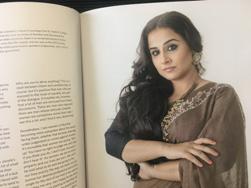

Canadian podcast Bollywood is For Lovers (BiFL) is well worth a try for your daily filmi fix. A fortnightly podcast presented by Alberta-based film buffs Matt Bowes and Erin Fraser, it is aimed at “introducing people to this vibrant 100 year-old film tradition”. In each episode, the selected films are discussed down to the very last detail – the social milieu in which the stories are based, cinematic issues, subplots, comparisons with other films of the genre, the marketing. Oh, and celebrity gossip as well, revealing how well the presenters know the desi setting. For us, what it boils down to, is looking at ourselves through the eyes of another. And enjoying that firang-accented Hindi!
Who doesn’t love an aloo tikki? One of northern India’s favourite street food, this winter favourite is a golden-fried potato patty (trust the Punjabis to like their potatoes deep-fried). What makes it unique is, it is stuffed with roasted dal and served with a variety of chutneys. It’s spicy, crispy hot and deeply satisfying. But if there is a way to better it, Sydney’s Urban Tadka Restaurant has found it in its new item, Aloo Ki Chaalu Tikki. A deconstructed version of the original, the chaalu format gives style to the street version, with its martini glass presentation and rimmed sev decoration. It still retains all its oomph though…. nothing can better the best, in that regard! The new item is especially popular at cocktail events, Inder Dua of the Terrey Hills based eatery tells us.
You can’t empower women without listening to their stories. NZ-based authors Geoff Blackwell and Ruth Halliday bring us empowering stories from across the globe in their book 200 Women. In answers to five questions, the subjects reveal their motivations and hopes, high points and low points, and pick a word that they most identify with. Read stories related by corporate women, environment activists, entertainers, Hollywood stars, home-makers, artisans and many more. From India, check out actor Vidya Balan, activist Vandana Shiva and youth entrepreneur Divya Kalia among others. Just as catching are the portraits of the 200 women, taken by Kieran E Scott against the same backdrop. Proceeds from sales go towards women’s causes around the world.

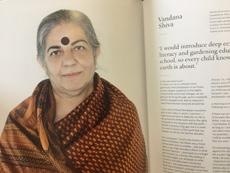
Brother based in Sydney seeks suitable match for 39-year-old Gujarati girl, Mumbai born, never married, 5’4”. Well cultured, medium build, BCom and working for international shipping company in Dubai. Hindu grooms please contact on 0416 475 948 or komaldxb@gmail.com
Seeking match for our daughter, Hindu, Australian citizen, 34, 5’4”, Masters in IT, working in a bank in Sydney, beautiful, fair, never married, vegetarian. Parents visiting Australia. Contact father 0402 265 428 or +91-98980 17279 (after August)
Seeking suitable match for Australian citizen Canberra-based Hindu girl, highly qualified IT professional. Parents highly educated and well settled in Sydney. Please respond to rukrghrmn@gmail.com
Seeking a 25-30-year-old Hindu/Punjabi girl settled in Australia for our 31-yearold son who is a surgeon, 5’9’’, born and brought up in Sydney. Please respond to gupta_rsr@hotmail.com
37, 5’11”, North Indian male, never married, Hindu/Hindi, fair, enjoys keeping fit, corporate & legal adviser, Melbourne born/based, seeks female, never married, tall, fair, interested in our Indian culture, traditions and values (inc. Hindi, food, music, film), enjoys keeping fit, enjoys all non-veg food, blend of intellect/cultured/worldly, appreciates the fragility of life and so prioritises the things that really matter. Please email ashok1940@hotmail.com with recent photo to connect.
List your matrimonial with Indian Link!



sales@indianlink.com.au
or phone (02) 9279 2004
Indians working overseas sent home
USD 69 billion as remittances in 2017*.
Not only does that account for 2.77% of the country’s GDP**, it places India on top of the list of countries receiving remittances from its diaspora across the globe. While this is interesting, what is more interesting is the story behind every remittance. These are stories of Hope, Happiness and Promise.
One such story is that of Sunita, a chartered accountant, who moved from Mumbai to Melbourne to pursue her career dreams. Leaving her parents and her brother behind was a tough decision since her father had retired and Sunita was the only earning member of the family. However, she could not let go of the opportunity to work in Australia. So while leaving for Australia, she made her family a promise: “I might be far away but I will always be there for you.” Sunita makes it a point to save a fixed sum of money post her expenses to send back home. She regularly sends money for household expenses, her
parents’ health insurance and for her brother’s university tuition fees.
Ganpat Rao, a farmer in Bolepali village of Maharashtra, too is a happy recipient of one such promise. He was struggling with meagre yield and even lower purchase price for his crops. Every year the situation only got worse. In spite of the hardships, Ganpat Rao ensured that his son Bhale Rao got a decent education. He didn’t want Bhale to be a farmer and suffer the same fate. Ganpat Rao had to borrow money to fund his son’s education. Bhale, being a witness to his father’s struggle to get him a university degree, put his studies to good use. He landed a job in Sydney as a software developer. When he was leaving for Sydney, he made a promise to his father. “Baba, I will repay your loans and make sure you will never have to borrow money again.” Bhale keeps his promise by sending money to his father regularly through Remit2India to manage the household and farm expenses. Ganpat Rao’s loans were all repaid by his son
Rahul Nand B.A. LL.B. (Tas) Partner, Notary Public Abhinav Sharma LL.M. (ANU) Solicitor Raj Bhandari LL.B. Honours (UK) Solicitor Ariza Arif (MQU) Law Clerk

“ ”
Sneha Deb LL.B. (WSU) Solicitor
3 Conveyancing Sale and purchase of residential property Fixed fee - no hidden charges 3 Compensation Claims Motor vehicle accidents and medical negligence 3 Family Law Divorce and Property Settlement 3 Criminal Law 3 Super, TPD and Income Protection claims 3 Wills, Probate and Estates 3 Power of Attorney and Guardianship 3 Notary Public
RN LEGAL Ph: (02) 9191 9293 Email: mail@rnlegal.org Suite 202, Level 2, 208 Forest Road, Hurstville NSW 2220 The RN Legal team did an excellent job. They were professional, friendly and helpful.
Do You Need Legal Help? We Can Help! Contact us to discuss your legal needs. 44916-RN Legal Advertisement 129x183 1017.indd 5 23/10/17 7:51:54 AM
www.rnlegal.org
home and Remit2India is one such PROMISES COME HOME WITH REMIT2INDIA

and he didn’t have to borrow money ever again. The son lived up to his promise and continues to do so.
ADVERTORIAL *World Bank report dated April 2018. ** World Bank report 2016 – Remittances as percentage of
Minal Khona has been reading tarot cards for the last two decades. She uses her intuition and connect with the cards mostly to help people.

March 21 - April 19
An idea manifests and gives you room for growth. Listen to your heart and not your head this month. You might take a decision you have been putting off for very long, and discordant thoughts in a difficult situation will dissipate. Take a break amidst nature, or pursue a hobby. Get in touch with your intuition to see what is really bothering you. Health issues revolve around the upper back. Success through a change in attitude is foretold.
LEO July 21 - Aug 22


All aces indicate a fresh start. The Ace of Pentacles for Leos indicates prosperity, new investments replacing old in terms of time, money or hobbies. You seek new pastures to challenge you and if you’re self-employed and working from home, you will see a surge in activity. Business will thrive and better health is all around. Money held up will come through; it will be more than you anticipated and a romance you thought was over will get revived.
SAGITTARIUS
Nov 22 - Dec 21
April 20 - May 20
There is a pause in the progress of a situation causing dissatisfaction or anxiety. You will want to re-evaluate your goals and aspirations. You will be disappointed in matters of romance and money causes anxious moments. Treat any deep-seated depression and related health issues if you are feeling indifferent towards everything. The universe is sending help in areas you need so have patience. Everything will resolve itself. Someone will help change a negative situation into a positive one.
VIRGO
Aug 23 - Sep 22
It is a difficult time as you feel restricted, oppressed perhaps, with health and work issues. But you will get out of this situation with clarity of thought. A beneficial trip is in the offing and if you are looking to sell property, you will succeed. You might just say no to a job you were not too keen on to start with. You could be accident prone so be careful. Understand that not all stressful situations are your doing.
GEMINI
May 21 - June 20
A change of heart in a romantic situation leads to new things. You might feel that your efforts are wasted in business. Work keeps you busy and leaves you no time to relax. Tension related health issues could crop up. Discussions regarding finances in business will result in you making money after giving concessions. Income equals expenditure this month so err on the side of caution. Stay calm and a new course of action could bring the change you seek.
LIBRA

Sep 23 - Oct 22
You could get influenced by a Leo type of personality – affectionate, generous, gregarious or shy, loyal and fun loving. You seek spiritual pursuits and if single, the prospect of a relationship is high. If already in one and things are bad right now, it could come to an end. Expect good news on the career front. You will seek new age remedies for health. Beware of family spats as the damage could be permanent. Decisions make themselves, so stay calm.





CAPRICORN

Dec 22 - Jan 19
AQUARIUS
Jan 20 - Feb 18
A tough month as things could get really bad before they get better. A stagnant situation or unfinished business – everything must get cleared out for new energies. In a romance, the worst is over so hang in there and things will improve. A makeover is indicated but avoid retail therapy. You could quit or be asked to leave a job. Don’t give up on yourself, a loved one or a stressful situation. Have faith; let go, let God handle it.
You will want to move onto a spiritual path and focus on intuition; men should tune into their feminine side more. Avoid conflicts and stay calm; don’t believe everything you see. Insights into reasons of why a partner or colleague is behaving a certain way will come to the fore if you trust your gut. Stay away from office politics. Women could have health issues related to their menstrual cycle. You will overcome setbacks.
You are in a passive state of mind and you would rather be than do. Emotions and intuition dominate. You are discontented because of what you lack but you don’t have a solution. Longing for love, strained communications with loved ones make you detached and withdrawn. Those trying to get pregnant will be successful. You might travel for work or pleasure. Visualise your outcomes for them to come true. Luck is on your side.
June 21 - July 20
Expansion, communication, arts, media and a person with a Gemini type of temperament are influencers this month. Expect an impasse in love but you will get unexpected validation from important or influential people at work. You are mentally preoccupied and emotions take a backseat. A new project gives you satisfaction and health improves on all fronts. Regrets of the past end and you move on. If estranged with a friend or lover, you will reconcile and a reunion is expected.
SCORPIO


Oct 23 - Nov 21
Destiny takes charge and material gains abound, as does spiritual poverty. You need to balance it out as old friends, lovers, habits and issues resurface. These are an indication of what needs to be cleared out and negative situations can be made positive by redirecting your energies. An old health issue crops up, needing medical attention. Your desire for change is so intense, that it will bring about what you seek with its intensity. Avoid bingeing on food or alcohol.
PISCES

Feb 19 - March 20
Reconciliation, reunions, and goal oriented planning occupy most of your time. Settlements of legal and income issues are predicted. You will want a better quality of love life over quantity. Money comes in sooner than expected. One cycle in your life will end and a new one will begin. There could be a divorce in the family. For any issues in business that have been bothering you, the best option is to wait for them to get resolved.
sordid image as a terrorist squarely on the media. There is a silly newspaper editor played by Prakash Belawadi who is shown as “guilty” of printing an article asking “Is Sanjay Dutt Finished?”.
Cut to an awards function where our screen Dutt wins the best actor for Munnabhai MBBS (he did win in real life). Dutt’s father, played by a hopelessly miscast Paresh Rawal, turns around and asks the editor to write another article stating Sanjay Dutt is not finished.
“And this time without the question mark,” the senior Dutt smirks.

STARRING Ranbir Kapoor, Sonam Kapoor Ahuja, Vicky Kaushal, Manisha Koirala, Paresh Rawal, Dia Mirza
DIRECTOR: Raj Kumar Hirani HHHHH
So, it was all the media’s fault. The newspapers, damn them, hid behind question marks and ‘sources’ to declare our Sanju Baba, arrey Sanjay Dutt yaar, a terrorist.
Raj Kumar Hirani’s long-awaited bio-

pic on the controversial star is long on drama, short on facts. It cleverly makes Sanjay Dutt look like a victim of his own naïveté. To his credit, Ranbir Kapoor plays Sanjay Dutt with such ardent goofiness and sincerely disingenuousness that I seriously began to wonder if the film’s opening joke -- about a bogus biographer played by Piyush Mishraof (all people!) likening Dutt to Bapu had come true.
Raj Kumar Hirani and his writer Abhijat Joshi lay the blame for Dutt’s
Like it or not, the plot of this semi-truthful bio-pic leaves us with many question marks. While it aptly focuses on building up a case beyond the legal one to substantiate Sanjay Dutt’s image as a victim of his own naivete, it brings into play characters and situations which have no place in the real Sanjay Dutt’s life. The girlfriends, whom we’ve all known through the years as being part of the Dutt folklore, are hurriedly dealt with as though they must be gotten out of the way. Sonam Kapoor appears to be playing an amalgamation of Tina Munim and Richa Sharma.

Sonam and Boman Irani (playing her dad) are made part of a horribly cheap joke where a dead-drunk Dutt and his evil conniving Parsi sidekick Zubin Mistry (played by an enormously hammy Jim Sarbh) create a drunken confusion over a drinking binge and the sex act.
Laboured and lewd the gag ranks right up there with Hirani’s “balaatkar” joke in 3 Idiots as the crest of tastelessness, any day filthier than the overflowing toilet in Dutt’s cell.
The modus operandi of this sinfully entertaining semi-fictional bio-pic is to blow up all the situations in Dutt’s drama out of all proportions, and then whittle them all down to a whiny protest where the protagonist becomes the portrait of self-injurious victimhood. Some of it works, thanks to the crackling immediacy that Ranbir and his screen-friend played by Vicky Kaushal bring to their roles. If only the screenwriter Abhijat Joshi had brought a more mature vision to this friendship.
The scenes showing Kapoor and Kaushal whooping it up are like scenes out of Hirani’s 3 Idiots. Again some of the situations created between the friends reek of lowbrow aspirations.
Karisma Tanna as Vicky Kaushal’s girlfriend who sleeps with Dutt deserves the award for the tackiest role played by a woman in recent times.
What works is the film’s ferocious pace. The narrative hurls across the catastrophic events in Sanjay Dutt’s life looking for ways to deflect the blame. Ranbir Kapoor and Vicky Kaushal furnish a funky brotherhood to this one-sided look at a controversial star’s life. Many of the other actors, specially Manisha Koirala as Sanjay Dutt’s mother - the legendary Nargis - hardly get time to breathe before the narrative hurls them into a whitewashing whirligig.
Wonder what the outspoken Nargis would have to say about this semitruthful bio-pic on her son.
Beta, late than never?
With a question mark, of course. Subhash K. Jha

She stole everyone’s hearts in her debut film Dum Laga Ke Haisha where she played bride to Ayushmann Khurrana’s character, who’s embarrassed to be hitched to a ‘chubby’ girl. In an industry that is, more often than not, obsessed with size zero figures, it was heartening to see a new actress make a mark in such an unusual role.
Clearly, Bhumi Pednekar loves a good challenge. In fact, it’s the reason we don’t see her on the big screen as often as we’d like. The actor says she chooses to stay away from projects that don’t test her abilities. Bhumi added that perhaps that’s the reason she isn’t seen in too many films.
Bhumi was most recently seen in the Lust Stories anthology. “I have been a huge fan of Zoya Akhtar and working with her was a big opportunity. When I heard the script of that segment in Lust Stories I realised that it is a challenging role and I really like to take up challenging roles,” she said.
Interestingly, she would like to see her “really pretty” twin sister Samiksha Pednekar in Bollywood. Well, so would we, but apparently she’s a hotshot lawyer so unless someone is threatening legal action against internet trolls… ahem ahem… we don’t see that happening.
Forget Priyanka Chopra and Nick Jonas for a while, okay? Let’s focus on the other celebrity couple that, for some reason, few people are talking about: Ranbir Kapoor and Alia Bhatt.
We all know that Ranbir is getting a lot of good feedback on his superlative performance in the ho-hum Sanjay Dutt biopic, Sanju. But it’s not just the general public oohing and aahing over his histrionics. Even rumoured girlfriend Alia can’t stop gushing over his performance (and rightly so).
“I really liked it. It is a fantastic, fabulous and an outstanding film. I think in my top 10 best film list, Sanju is high up there. Ranbir is outstanding in it. Vicky Kaushal and Paresh ji (Rawal) also did a fantastic job. Everyone including Anushka (Sharma) and Sonam (Kapoor) did a really good job. It’s a full package,” she said.
Ok, so she gushed over just about everyone, but we are being selective here. She even went on to say that Sanju is “one of the best films in the past couple of years”. Hmm, don’t know about that Alia, but we know where you’re coming from. Wink wink!

Priyanka Chopra isn’t just a “favourite actress” – she’s a role model. Recently, Alyssa Raghunandan, an Indian-origin singer on the popular singing reality show American Idol says she “wants to be just like Priyanka Chopra”.

The 15-year-old didn’t win, but she left the Grammy nominee and judge Katy Perry mightily impressed when she said she would like girls everywhere to know that they don’t have to “show skin” to get ahead in life.
“I want to be like Priyanka Chopra. I feel she is an incredible role model,” said Alyssa, adding that she singing with the actor would be like a dream come true for her. “That is my dream. If I ever had that opportunity, I think my life would be set. I will be the happiest girl in the world,” she said. Sweet, don’t you think!
We like Sonam Kapoor, love her even. Is she a designer’s dream come true? Yes. Is she a fashionista making India proud on the blingy red carpets of the world? Definitely. Is she fun to follow on Instagram. Yessiree. Has she given eight hit films in a row? Huh? Say what?
Dad Anil Kapoor tweeted recently about how proud he was about how his daughter had made some “pretty damn good” choices in her film career. We almost choked on our coffee (whether it was from laughter or shock, we won’t say).
Parents will be proud of their children, no matter how far they go in
life. It’s what parents do. But surely this statement was a little… out there?
“The choices we make shape our lives. Sonam, you have made some pretty damn good ones when it comes to scripts, directors and content... Your hard work, commitment and conviction have resulted in 8 hits in a row! So happy and proud of you!”
Anil shared snapshots of Neerja, Raanjhana, Bhaag Milkha Bhaag, PadMan, Khoobsurat, Prem Ratan Dhan Payo, Veere Di Wedding and the latest, Sanju.
No one can deny that Sonam gave her best in Neerja and Raanjhana. Maybe even PadMan and Veere Di Wedding. We won’t deny that she seems to be making an honestto-god effort to better herself. But Khoobsurat? No. Bhaag Milkha Bhaag? Where she came on screen for 10 minutes tops. No.
We’re all for father-daughter love, but let’s not stretch it.
It’s been 20 years since one of Bollywood’s most iconic films was released: Satya. Ram Gopal Varma may have amassed a lot of hatred and criticism for his catastrophes like Ram Gopal Varma ki Aag and Department, and acclaim for Sarkar, but before all of that happened, Satya happened.
The film has achieved something of a cult status for its realistic depiction of the Indian underworld. Two decades later, Varma has revealed that the success was totally accidental.
“Tomorrow is the 20th birthday of ‘Satya’. It was an accident,” Varma tweeted.
The filmmaker said the secret to its success was that he stopped telling his actors what to do. “I went half by instinct and half by Anurag’s (Kashyap) manic way of writing highly realistic dialogue. Actors were instructed to say whatever they felt like. So they kept improvising and I edited the rest,” he said.
Fancy that. If only more filmmakers took such risks with their films, might we get better films? Who knows!
Although he created quite the buzz with his debut film Tere Bin Laden and
a few others, in India, Ali Zafar is now looking to impress Indian cinegoers with his maiden film in Pakistan, Teefa in Trouble, which releases on 20 July.

Knowing the tense state of relationship between the two countries, however, the question is whether the film will even come to India. But Zafar is hopeful. “We have made the effort, given our best. It is all about giving respect and getting respect back. It is a film, it is entertainment. I hope that it gets screened over there (in India) and makes a mark and more stuff like this should happen. My job is to try. I don’t think about the negative side at all,” he said.
“As an artiste, I feel that our work should be heard and viewed by as many people as possible in the world. I think we want that there should be peace... peace, having a cordial relationship and love are what we all want to prevail.”
Here’s hoping the politicos (you know who we’re talking about) stay away from this one and we see your film in India soon, Ali.

If there’s one actor who was known for her acting as much as for her dancing, it’s Madhuri Dixit. She brought zing into any number she performed on the big screen, and why wouldn’t she? She’s a trained classical dancer herself. The actor says her secret to being a great
dancer is the foundation of her talent.
“I stress on the importance of learning classical dancing because it gives you a sense of discipline, rhythm and expression. So, your foundation as a dancer gets set strong. Then, you can do any form of dance.”
She added, “For eight years as a kid, I only learnt kathak and practised for hours. After that, when I started trying out different styles of dancing, my body movements flowed in a certain manner, making the dance look graceful, effortless and everything that people talk about.”
But aren’t youngsters (and Bollywood in general) leaning more towards western dance these days? After all, when was the last time anyone saw a proper, “non-western” dance in a Bollywood film? “I think one of the reasons why western dance is getting more popular than our traditional Indian dance among masses is that you have to learn kathak and Bharatanatyam under the guidance of a Guru, whereas in western dance, you can copy from the video. There is a difference.”
Er, are you sure about that, Madhuri? Ever watched So You Think You Can Dance?
BUSTING STEREOTYPES: RICHA

Why is it that the minute a non-Indian starts talking about “Bollywood” the
first (and sometimes, the only) thing that comes up is Slumdog Millionaire? Or how “Indian films” are all about song and dancing around the trees? Stereotypes like these really need to be busted, says Richa Chadha.
The actor, who was honoured at the Bagri London Indian Film Festival (LIFF) with an Outstanding Achievement Award recently, said that festivals like LIFF are instrumental in promoting films other than the usual commercial cinema.
Richa is not one to preach and not practise. The actor is known for her offbeat characters in films like Fukrey, Goliyon ki Rasleela: Ram Leela and Masaan. She stars in Love, Sonia, which was the festival’s opening night movie.

“When you say Indian films, people assume it’s just Bollywood and that’s untrue,” she said. “We have independent films… Festivals like LIFF help us in making the right noise back home, so these films stand a chance against the mainstream expensive (movies).”
Other winners at LIFF included Irrfan Khan and Manoj Bajpayee, both of whom an Icon Award.

Match the following stars to their tweets: Alia Bhatt, Huma Qureshi, Rajkummar Rao, Uday Chopra.
The first time I encountered @ TheFarahKhan was at a Diwali party. I was sleepy and wanted to go to bed and when I went to my room she was sleeping there. I ran downstairs and said there’s a girl in my bed and everyone said ya that’s Farah.
Happy birthday my favourite #MerylStreep. Am sure these two people, @karanjohar & @Patralekhaa9 are very happy that this “Iron Lady” was born today. I know you both love her the most.

I have never been to #Disneyland It’s just sad.
Shaheen you are brilliant! My sister has battled and lived with depression since she was 12. She speaks her heart out and without any hesitation addresses the giant elephant in the room
What’s the chit-chat between SANJAY DUTT and RANBIR KAPOOR?

Send your response to: media@indianlink.com.au TO WIN A MOVIE TICKET!!
Anuskha: “Beta, raste pe kachra nai karte!”
SATISH JOSHI, NSW
Congratulations, Satish! You win a movie ticket!
Another good one: Anushka: “Since you are away most of the time, this will keep me company.”
RAJ SANEJAI’ve been dabbling in a spot of scuba diving. A surprise to myself as well as those who know me. Being painfully un-athletic and colossally uncoordinated (who put that wall there?!), I never saw myself in a wetsuit, 20-something metres underwater, breathing from a tank and incredibly, not freaking out!
When my now husband (then boyfriend) gifted me with a scuba-diving certification course for my birthday, I tried to appear nonchalant. Inside, I thought ‘Who is this (surely crazy) man who had cleverly ignored my multiple declarations that I was not the ‘athletic type’?’ In fairness, how was he to know that I had given up all romantic dreams of being a marine zoologist, inspired by 90’s shows Ocean Girl and Seaquest DSV, because I could only swim backstroke?
That any attempt to swim any other stroke ended in me giving up, a spluttering mess, because I hated having to breathe out underwater? How was he to know that
any of my athletic pursuits as an adult were negatively shaped by having been the quiet, chubby, bookish Indian kid in Penrith in the ‘90s, always the last in the class to be ‘chosen’ by a team for any sport?
That’s right, he wasn’t to know. He must have sensed something though because he did tell me he would understand if I didn’t want to do it.
Challenge accepted.
Actually, it was my ‘safety-first-call-uswhen-you-get-there’ mum who further encouraged me to do the course. “Conquer your fears!” she exclaimed. “Learn a new skill!” And so I did, but I won’t pretend that I took to it like a fish to…..errr…you know.
I was the worst in the class, so much so that the assistant instructor was assigned to me exclusively. After a two-day intensive course, the instructor told me that he was impressed because although I had buoyancy issues, seemed terrified, and generally just wasn’t great at scuba (still waiting for the compliment….), I somehow managed to stay calm and not do anything stupid or dangerous.
Ok, I’ll take that.
Being a serial over-thinker is something I had to push aside. Because really, if I allowed myself the luxury of thinking about it...‘I am underwater, people!! Breathing from a tank!! With compressed
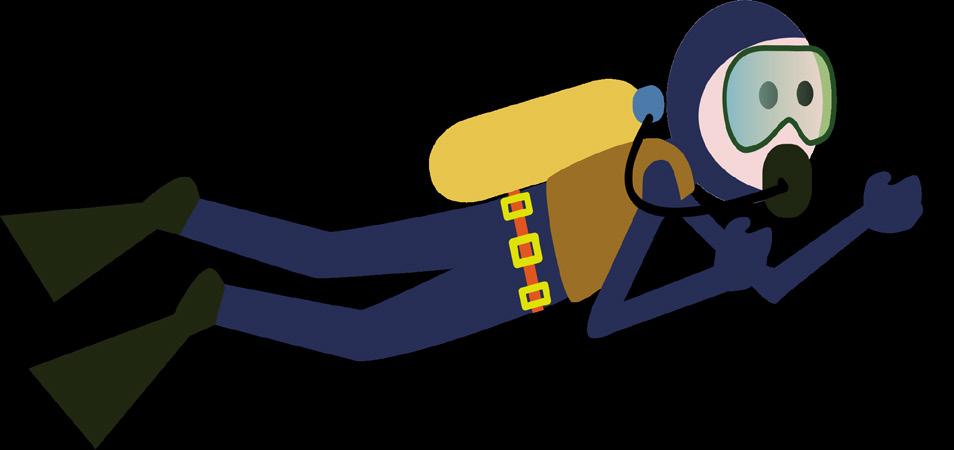
air in my lungs!! Air that can diffuse into my bloodstream and form painful bubbles if I come to the surface too quickly! This is not natural! Humans were not supposed to breathe underwater! Also there are big scary animals with sharp teeth that can swim faster than I can!
What was I thinking? Why would I jump out of a perfectly good boat or walk off a perfectly solid shore to breathe through a tank underwater?!’
So as you can see, my usual overthinking habit has no place in a dive. Instead, I am learning to quiet my mind
and enjoy the peace and beauty of the underwater world. Once I get past the panic, the stillness and slowness and ‘floatiness’ of it all makes it a beautiful, almost a meditative experience. If I’m lucky, I’ll see something beautiful to distract me when my mind wanders to unwanted places.
A gorgeous school of fish, zebrastriped with fluorescent green dorsal fins, engaged in a perfectly coordinated dance - an underwater flash mob. Or a baby shark, hiding under a soft coral, biding its time until it is big enough to survive the big bad ocean. It is wonderful to have something that husband and I can do together on holiday. An experience we can share and chat excitedly about, or even quibble about afterwards! For me, it is the conquering of a fear. Not the fear of water or underwater creatures, but the fear that I am not ‘athletic enough’ to do anything so incredible.
Also, I must be getting the hang of it. On my last dive, I didn’t panic once, not even when we saw the huge bull-ray. We had a big friendly groper fish follow us like a puppy for most of the dive, and I didn’t crash into the fellow once! I was even told that I no longer look like I’m having a seizure underwater.
Again, I’ll take it.
If
INDIA
INDIA TOURS AND TRAVEL SPECIALISTS




Have a dream holiday of your life in India
"If
6, VERNON STREET, TURRAMURRA, NSW 2074
6,
TEL: MOB:0424257087
TEL: MOB:0424257087
E:ram@ramworldtravel.com.au. web:www.ramworldtravel.com.au
E:ram@ramworldtravel.com.au. web:www.ramworldtravel.com.au
Although I had buoyancy issues, seemed terrified, and generally just wasn’t great at scuba, I somehow managed to stay calm and not do anything stupid or dangerous






























